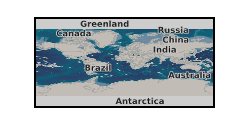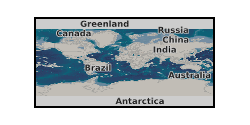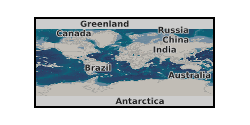Nitrogen
Type of resources
Topics
Keywords
Contact for the resource
Provided by
Years
Formats
Representation types
Update frequencies
-

Measurements of the nitrogen content of hydrothermal graphite deposits and associated silicate rocks. The samples are of Paleoproterozoic age and allow constraining the behavior of nitrogen in abiotic hydrothermal graphite-forming systems. The results provide context for evaluating the biogenicity of Eoarchean graphite. More details are presented in Stüeken, E.E., Szilas, K. and van Hinsberg, V.J., 2023, Chemical Geology, 617, p.121274.
-

The data set contains major, trace element, and stable isotope (Si, Zn, Mo, V, Tl, Zr) from previous studies and new nitrogen abundance and stable isotope values for 17 samples spanning a range of igneous rock types (basalt, andesite, dacite, rhyolite). The samples are apheric extrusive volcanic rocks from Hekla volcano, Iceland.
-

Peat properties data and age depth models for 102 peat cores extracted and analysed for the Increased Carbon Accumulation in Arctic Peatlands (ICAAP) project (Grant NE/S001166/1). Peat cores were extracted from 12 peatland sites from four regions of the Arctic: Svalbard (78.09065°N 14.98407°E; 78.98595°N, 11.98246°E; and 78.95872°N, 11.68331°E), Norwegian and Finnish Lapland (70.11876°N, 28.48351°E; 69.80659°N, 27.19732°E; and 69.38787°N, 24.24123°E), Nunavut, Canada (72.655515°N, 78.061646°W; 72.694207°N, 77.864603°W; and 73.13028°N, 80.022987°W), and Quebec, Canada (62.165681°N, 75.915017°W; 62.123168°N, 75.769467°W; and 62.157355°N, 75.607301°W). Data originates from the analysis of Arctic peat cores for changes in rates of lateral expansion and vertical peat accumulation during recent centuries. Specifically, peat cores were analysed for moisture content (%), dry bulk density (g cm-3), C/N content (%), 210Pb activity levels (bq/kg), and 14C radiocarbon age (yr BP).
-

This dataset contains the nitrogen, oxygen, and lithophile element geochemistry of whole rock, and distribution coefficients, and stable isotope fractionation factors for biotite, orthoclase, and plagioclase mineral separates from the Loch Doon Zoned Pluton, Scotland. The samples were collected from the northern limb of the Loch Doon pluton and are petrologically classified as are granodiorites and granites which show geochemical evidence for being a cogenetic zoned pluton. The data were collected over a time period of 2019-2022. These data were collected to investigate elemental partitioning and stable isotope fractionation of nitrogen between biotite, plagioclase, and orthoclase relative to each other and to the system (whole rock) during magmatic differentiation. This project was curiosity-driven science, and the anticipated interest groups are assumed to be the wider research community via scholarship and analytical protocols. These data were collected by an international team of scientists as part of Dr Toby Boocock’s PhD project. The full list of contributors are shown below: Boocock, TJ., Stüeken, ES., König, R., Mikhail, S, The University of St Andrews, UK (performed analysis, acquired samples, interpreted data) Bybee, GM, The University of the Witwatersrand, South Africa (performed analysis) Boyce, AJ, Scottish Universities Environmental Research Centre, UK (performed analysis) Prytulak, J, Durham University, UK (interpreted data) Buisman, I, University of Cambridge, UK (performed analysis)
-

Nitrogen abundances in red shales are shown to be suitable as a biosignature that may be applicable to red beds on Mars. The data set includes organic carbon and nitrogen abundances and isotopic ratios, carbonate carbon and oxygen isotope ratios, and metal abundances. We evaluate potential abiotic effects and discuss diagenetic scenarios that lead to an enrichment of ammonium in clay minerals.
-

Isotope tracing data for 14C, 15N and 33P tracing between plants and symbiotic fungi in Lycopdiella inundata, Anthoceros and Phaeoceros sp. and Lunularia cruciata. All plants tested and traced in atmospheric CO2 conditions of 440 ppm [CO2] and 800 ppm [CO2]. Datasets includes total mass of plants and soils, Bq in each component of experimental systems and values in Bq and mg where appropriate.
-

The data include organic carbon and nitrogen abundances, carbon isotopes, nitrogen isotopes, major and trace element abundances, RockEval and mercury abundances from sedimentary strata across the Paleocene-Eocene thermal maximum. The samples include areas with hydrothermal influence linked to the emplacement of the North-Atlantic Igneous Province and others distal to hydrothermal activity to evaluate the effect of hydrothermal circulation on geochemical cycles. The results are linked to Rochelle-Bates et al. (in prep.) "Hydrothermal ammonium from a Large Igneous Province mitigated early Eocene climate change". * Note: U1568A Rockeval : Red filled cells highlight unreliable data with Tmax less than 350°C or greater than 450°C, or oxygen indices greater than 200.
-

Trace element and isotope data measured on 36 sediments that record the opening of the south Atlantic preserved onshore, Brazil. The samples come from two main pre-salt sections within the Araripe Basin close to Juazeiro do Norte, Ceará State: the Três Irmãos quarry which records a lacustrine succession and the younger Sobradinho River Section which is a sequence of organic-rich, ostracod-bearing mudstones. Additional gypsum and ostracod samples, procured from two quarries within the Araripe Basin, were analysed to provide data from the main salt-forming interval. The samples were collected during 2023 by a team from Bristol University (Ian Parkinson, Rachel Flecker), Sao Paolo State University (Rafaela Cardoso Dantas) and University of Utrecht (Dan Palcu). The samples were analysed at Bristol University 2023-24 as part of the PhD project of Rafaela Cardoso Dantas. The aim was to use the Sr isotope and Os isotope data to reconstruct the connectivity between the global ocean and opening South Atlantic. Trace element, carbon and nitrogen analysis were analysed to help reconstruct the environmental conditions in the basin.
-

We investigated the physical basis of this weakened trapping using pore scale observations of supercritical CO2 in mixed-wet carbonates. The wetting alteration induced by oil provided CO2-wet surfaces that served as conduits to flow. In situ measurements of contact angles showed that CO2 varied from nonwetting to wetting throughout the pore space, with contact angles ranging 25° <θ< 127°; in contrast, an inert gas, N2, was nonwetting with a smaller range of contact angle 24° <θ< 68 °. Observations of trapped ganglia morphology showed that this wettability allowed CO2 to create large, connected, ganglia by inhabiting small pores in mixed-wet rocks. The connected ganglia persisted after three pore volumes of brine injection, facilitating the desaturation that leads to decreased trapping relative to water-wet systems. This data is associated with this open access publication: Environ. Sci. Technol. 2016, 50, 18, 10282-10290. https://doi.org/10.1021/acs.est.6b03111.
 NERC Data Catalogue Service
NERC Data Catalogue Service